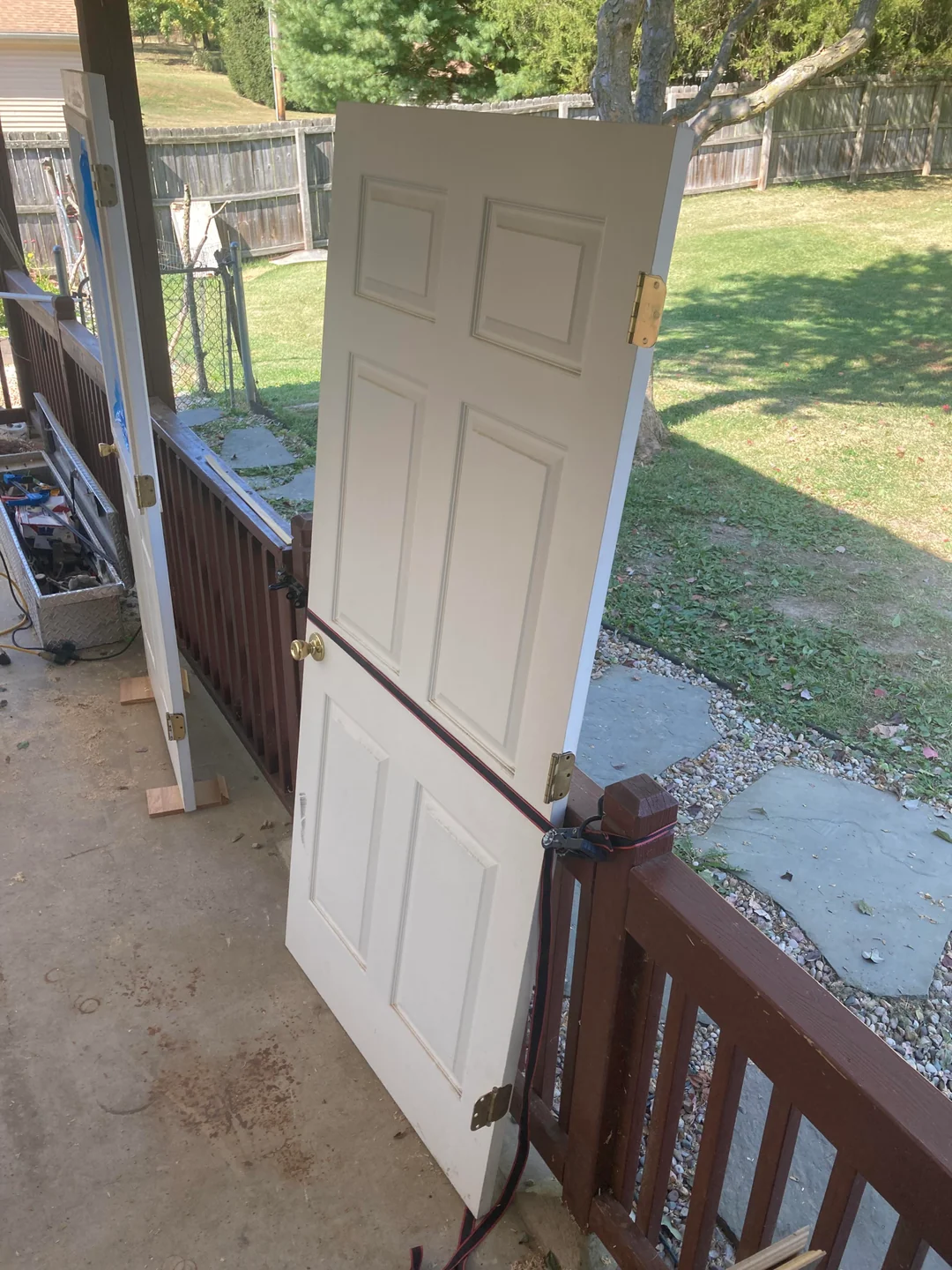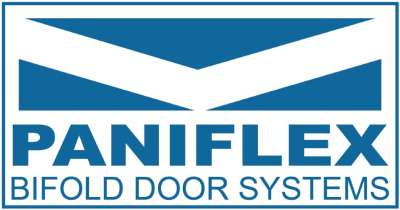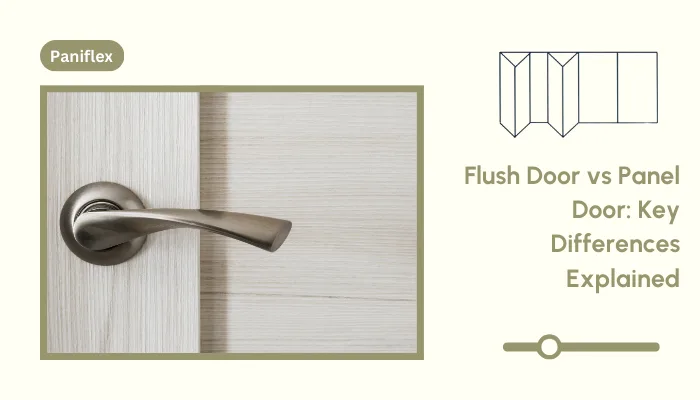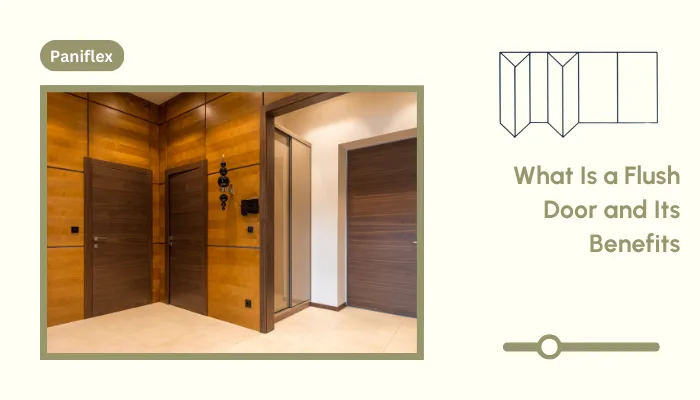The choice between flush doors and panel doors can significantly influence the style, functionality, and budget of a project. Both have distinct features that make them suitable for different applications, from modern minimalist spaces to traditional interiors.
We understand that selecting the right door type is about balancing design, performance, and client expectations. This guide breaks down the key differences between flush and panel doors, helping you make informed decisions that perfectly fit your next project.
Ready to experience the benefits of custom closet doors? Explore our range of Paniflex products now.
Overview:
- Flush and panel doors differ in construction, style, durability, and suitability for various project types.
- Understanding these differences helps architects and contractors specify the right door for function, design, and budget.
- Panel doors offer timeless detailing ideal for high-end and heritage spaces.
- Flush doors provide sleek minimalism and cost efficiency for modern, large-scale projects.
What Are Flush Doors?
Flush doors are a popular choice in modern projects for their clean, minimalist appearance and versatile applications. They feature a flat, smooth surface and are constructed with a solid or hollow core, often finished with veneer or laminate.
Flush doors are valued for their simplicity, making them suitable for contemporary interiors, commercial spaces, and cost-sensitive projects without compromising durability. They are useful for the following reasons:
- Lightweight and easy to install.
- Available in solid, hollow, or laminated core options.
- Minimal detailing suits modern and transitional designs.
- Affordable compared to detailed panel doors.
- Requires less maintenance due to the absence of grooves and joints.
Now that you know what flush doors are, let’s step into the world of panel doors and see how they differ in design and structure.
What Are Panel Doors?
Panel doors are a classic choice known for their detailed design and sturdy construction. Built with stiles, rails, and panels, they offer depth and character that complement traditional and high-end interiors.
Their framed structure allows for variations in design, including raised, recessed, and glass panel inserts, making them highly versatile for both residential and commercial projects.
- Available in multiple designs, like raised panels or shaker styles.
- Strong and durable, ideal for high-traffic areas.
- Provides excellent sound insulation and thermal performance.
- Better suited for traditional, colonial, or heritage character.
- Can be customized with intricate detailing and finishes.
With a clear understanding of both door types, let us compare them directly to see how they perform across key design and functional parameters.
Suggested Read: How to Fix a Large Gap Under the Door?
Flush Door vs Panel Door: A Head-to-Head Comparison
Choosing between flush and panel doors involves more than just appearance. Each offers unique advantages in design, durability, cost, and performance. This section breaks down these differences to help you make informed decisions for your projects.
Quick comparison table:
| Feature | Flush Door | Panel Door |
|---|---|---|
| Design | Minimalist, flat surface | Detailed, classic, or ornate |
| Construction | Solid/hollow core with veneer | Frame and panel assembly |
| Cost | More affordable | Generally higher cost |
| Maintenance | Easy to clean, fewer crevices | Needs more care, dusting crevices |
| Durability | Good in low to medium traffic | Excellent in high-traffic areas |
These differences are explained in greater detail below:
1. Design
Flush Door:
Flush doors are designed with sleek, uninterrupted surfaces that create a smooth, modern look. Their minimalist approach works well in contemporary interiors where simplicity and subtlety are prioritized.
They are perfect for spaces that require a clean, uniform look, such as office buildings, modern homes, or apartments with minimalist decor.
The absence of intricate details or ornamentation keeps the overall design streamlined and consistent, often making it the go-to choice for those who prefer a modern aesthetic.
Panel Door:
Panel doors introduce a sense of richness and dimension through their multi-layered design. With panels often framed by stiles and rails, these doors are versatile, adding visual interest and texture to more traditional or transitional interiors.
The depth created by the panels allows for the incorporation of more decorative elements like raised, flat, or beveled panels, making them a great choice for spaces where a more classic or decorative appearance is desired.
Panel doors work exceptionally well in homes with historical or antique décor, or even in formal settings like libraries and grand foyers.
2. Construction and Materials
Flush Door:
Flush doors typically feature a solid or hollow core construction, making them relatively lightweight compared to other door types. The core can be made from various materials, such as MDF or plywood, depending on the desired strength and weight.
The exterior is often finished with a veneer or laminate material, which is durable and easy to maintain. The simplicity of the construction makes flush doors affordable, but they still provide solid functionality and an aesthetically clean look.
The smooth, flat surface makes them highly adaptable to a range of finishes, including high-gloss, matte, or wood textures.
Panel Door:
Panel doors are built with a more intricate structure, often crafted from solid wood like oak, maple, or cherry, which provides both strength and an upscale appearance. The door consists of stiles (vertical sections), rails (horizontal sections), and panels, which can be raised, flat, or even frosted depending on the design.
This detailed construction results in a premium door that often requires more material and craftsmanship. The use of solid wood enhances the door’s strength. It also contributes to its refined look, making it ideal for high-end interiors.
3. Cost and Affordability
Flush Door:
Due to their simple construction and use of lightweight, cost-effective materials like MDF or plywood, flush doors tend to be much more affordable compared to panel doors. This makes them a popular choice for large-scale projects, such as commercial buildings, apartments, or homes on a budget.
The reduced complexity in their design means fewer materials and less labor required to produce them. Flush doors are often favored in situations where functionality and affordability are the primary concerns, without sacrificing too much on visual appeal.
Panel Door:
Panel doors come at a higher price point due to their more intricate design and the higher quality materials required, such as solid wood. The detailed craftsmanship needed to create the panel sections and frames also adds to the cost.
This makes them ideal for projects that are willing to invest in style and durability. Panel doors are often found in high-end residences, custom builds, or luxury commercial spaces where looks and long-term value are key considerations.
While the initial cost is higher, panel doors can contribute significantly to the overall design scheme of a home or building.
4. Durability and Performance
Flush Door:
While flush doors provide a sleek and minimalistic design, their durability is best suited for low to medium-traffic areas. The hollow core construction, while effective in reducing weight, can make them more vulnerable to damage from impact or heavy usage.
They are generally more suited for bedrooms, bathrooms, or other spaces that don’t experience constant wear and tear. Over time, they may show signs of dents, scratches, or wear, particularly in environments with high humidity or heavy foot traffic.
Panel Door:
Thanks to their solid construction and use of premium materials, panel doors offer superior durability. The structure of stiles, rails, and solid wood panels makes them particularly strong, ideal for high-traffic areas such as living rooms, kitchens, hallways, or commercial spaces.
Panel doors are less likely to show wear over time, as they are able to withstand heavier impacts and the daily demands of active households or workplaces.
5. Maintenance Requirements
Flush Door:
One of the major benefits of flush doors is their low maintenance needs. The smooth, flat surfaces minimize places for dirt, dust, and grime to accumulate, making cleaning quick and easy.
A simple wipe-down with a damp cloth is often enough to keep them looking pristine. This ease of maintenance makes flush doors ideal for spaces that demand simplicity and functionality without the need for constant care or attention.
Panel Door:
While panel doors offer a high-end appearance, they do require more maintenance due to their intricate design. The grooves and raised panels can trap dust, dirt, and cobwebs, requiring more frequent cleaning. In addition, the solid wood materials may need to be refinished periodically to maintain their luster and protect against wear.
Over time, the wood may also warp or crack due to changes in humidity and temperature, necessitating upkeep to ensure the door remains functional and aesthetically pleasing.
Suggested Watch: This video shows how to turn a flat (flush) door into a panel door.
Factors to Consider When Choosing a Door

The decision between flush and panel doors goes beyond looks. It involves evaluating functional needs, design goals, and long-term performance for the specific space. Here are the key factors professionals should weigh during the selection process.
1. Design Vision and Interior Style
The door style must align with the overall design. Flush doors suit modern, minimal spaces needing clean lines and subtle elegance. Panel doors bring texture and depth, ideal for traditional, colonial, or transitional designs where visual detailing enhances the architectural character of the space.
2. Budget and Project Scale
Cost plays a crucial role in door selection. Flush doors are cost-effective, perfect for large developments or cost-sensitive renovations. Panel doors, though more expensive, deliver a premium look. They suit boutique projects or luxury residences where design richness and client expectations justify higher investment.
3. Traffic Levels and Durability Needs
Evaluate how much wear the door will endure. Flush doors work well in low to moderate traffic areas like bedrooms or offices. Panel doors, with their sturdy construction, are ideal for high-traffic spaces like hotels, schools, and entryways where durability and longevity are essential.
4. Environmental and Moisture Exposure
Humidity and temperature shifts impact door performance. Flush doors with engineered cores resist warping in moisture-prone areas. Solid wood panel doors, while beautiful, can swell or shrink in extreme conditions unless properly sealed. Site environment should guide material and finish selection.
Choosing between flush and panel doors might seem simple, but the right fit depends on your space. Let’s explore where each works best.
Suggested Read: How to Install Bifold Door Snugger: A Basic Guide
Where Should You Use Flush Door vs Panel Doors?
The choice between flush and panel doors depends on the specific requirements of the space, including design, durability, and maintenance needs. Here’s a breakdown of where each door type performs best.
Flush Doors
Not every door style fits all environments. Flush doors, with their clean lines and practical design, are perfect for spaces where functionality and simplicity are key.
Here are some ideal settings for flush doors:
- Commercial Spaces: Best for offices, retail stores, and institutional buildings. The sleek design and low-maintenance surfaces handle high-usage environments efficiently.
- Modern Apartments: A great choice for contemporary apartments and condominiums that need sleek, budget-friendly doors with a minimalistic appeal.
- Moisture-Prone Areas: Suitable for kitchens, bathrooms, and utility spaces, provided they are properly sealed to resist humidity and prevent swelling or warping.
- Institutional Buildings: Practical for schools, hospitals, and public buildings that require durability, easy maintenance, and cost-effectiveness for large-scale installations.
Panel Doors
Panel doors shine in settings where elegance, craftsmanship, and visual appeal are essential. Their rich detailing works well in spaces that need to make a statement.
Consider panel doors for:
- High-End Residences: Perfect for luxury homes and boutique projects where intricate detailing and craftsmanship add depth and elevate the interior design.
- Heritage or Traditional Projects: Ideal for restorations or heritage properties where classic design and structural depth are essential for maintaining authenticity.
- Hospitality Projects: Works well in hotels and resorts where premium design and acoustic performance are crucial for guest satisfaction.
While choosing between the two, many professionals encounter persistent myths that influence their decisions. Let us address some common misconceptions about flush and panel doors.
Common Misconceptions About Flush and Panel Doors
Misunderstandings about flush and panel doors often lead to poor specification choices. Clarifying these myths helps professionals align door selection with real-world performance and client expectations.
Myth 1: Flush Doors are Weak and Cheap
This is not true for well-made flush doors. High-quality variants with solid or engineered cores offer excellent strength and stability. When manufactured with premium materials and finishes, flush doors can withstand daily wear and tear in both residential and commercial environments, just like panel doors.
Myth 2: Panel Doors are Always Better
Panel doors bring craftsmanship and elegance, but they are not a one-size-fits-all solution. Flush doors often outperform them in modern interiors where sleekness and minimalism are key. Each door type has unique strengths depending on design goals and functional requirements.
Myth 3: Flush Doors Cannot Handle Humidity
Properly sealed flush doors with moisture-resistant cores perform well even in kitchens and bathrooms. The misconception arises from hollow-core or poorly finished products that fail due to moisture. Quality flush doors are designed to resist warping and swelling in humid conditions.
Myth 4: Panel Doors are Outdated
While some view them as traditional, panel doors have evolved with modern styles like shaker and slimline profiles. They remain popular in high-end homes and transitional spaces for their depth, texture, and timeless appeal. Modern finishes make them suitable for contemporary interiors too.
Myth 5: Flush Doors Lack Design Flexibility
Flush doors offer surprising versatility in materials and finishes. Veneers, laminates, and even integrated glass panels can elevate their style. Their smooth surface acts as a canvas for creative finishes, making them adaptable to a wide range of design schemes.
From the Community: This Reddit thread discusses the cost efficiency of a flush door versus a panel door.
Installation Differences and Considerations

The installation process for flush and panel doors differs due to their distinct constructions. While flush doors are simpler and quicker to install, panel doors require more precision and careful alignment.
This is explained better below:
1. Flush Door Installation Differences
The installation of flush doors is generally simpler, but there are still some unique aspects to keep in mind. Here are the key differences when installing a flush door:
- Hinge Alignment: Flush doors are lighter and simpler, so the hinge placement requires less precision.
- Handling: Due to their lightweight nature, flush doors are easier to handle and install with minimal assistance.
- Frame Preparation: Flush doors require less adjustment to the frame, as their smooth design doesn’t demand precise alignment of panels.
Pro Tip: To ensure the flush door fits perfectly, double-check the frame dimensions before purchasing, as even a slight mismatch can cause alignment issues.
2. Panel Door Installation Differences
Installing a panel door requires more attention to detail due to its design and construction. Here are the main differences when installing a panel door:
- Hinge Alignment: Panel doors require more precise hinge placement, as their intricate design and heavier weight need more careful handling.
- Handling: Because of their solid construction and weight, panel doors are typically heavier and may need additional assistance for proper placement.
- Frame Preparation: The frame must be more meticulously checked to ensure proper alignment of the stiles, rails, and panels to prevent misalignment.
Pro Tip: When installing a panel door, ensure the stiles and rails are perfectly aligned to avoid any warping or misalignment of the panels during installation.
With the right installation practices in place, Custom Door & Mirror ensures its flush and panel doors integrate seamlessly into any project, offering both style and reliability. These features are explained in greater detail in the next section.
Suggested Read: Guide To Sizing A Rough Opening For Bifold Doors
Custom Door & Mirror Solutions for Custom Doors
Custom Door & Mirror has built a reputation for delivering doors, mirrors, and hardware that combine design excellence, durability, and flawless installation. Their approach focuses on meeting the unique needs of architects, designers, and contractors without compromising on quality or timelines.
1. Specific Designs
From minimalist flush doors to detailed panel designs, Custom Door & Mirror offers a wide range of styles. Each door is crafted to align with the project’s style vision, ensuring seamless integration into modern, traditional, or transitional spaces.
2. Built for Durability
The doors are engineered to withstand heavy use and environmental factors. Solid cores, premium finishes, and robust hardware choices ensure longevity, even in high-traffic or moisture-prone areas like commercial spaces and residential bathrooms.
3. Value Without Compromise
Custom Door & Mirror prioritizes value for money without cutting corners. Their doors balance cost efficiency with high-quality materials, providing clients with reliable products that meet budgetary and design goals simultaneously.
4.Timely Deliveries
With streamlined production and delivery systems, they ensure doors arrive on schedule. This helps contractors and designers meet tight timelines and avoid costly delays during the installation phase.
Custom Door & Mirror’s solutions go beyond just supplying doors. They offer peace of mind. Their commitment to quality, design flexibility, and on-time delivery makes them a trusted partner for projects of all scales. We avoid cost-cutting measures, ensuring every product delivers long-term value and durability.
Ready to experience the benefits of custom closet doors? Explore our range of Paniflex products now.
Conclusion
Choosing between flush and panel doors is not just about style. It is about aligning design vision, functionality, and long-term performance with the needs of your project. Understanding their differences helps architects, designers, and contractors make smarter, more confident decisions.
At Custom Door & Mirror, every door reflects precision, durability, and a commitment to project success. Timely deliveries and consistent craftsmanship make us a trusted partner for architects, designers, and contractors.
Ready to improve your next project with doors that deliver on both form and function? Contact us to find solutions that fit your design and performance needs perfectly.
Frequently Asked Questions
1. What makes a flush door different from a panel door?
A flush door has a flat, smooth surface with minimal detailing, while a panel door features stiles, rails, and raised or recessed panels that create depth, texture, and a more traditional appearance.
2. What is the difference between a hidden door and a flush door?
A hidden door blends seamlessly into walls or cabinetry for a concealed look, often using flush construction. A flush door has a flat surface but remains visible within the interior design.
3. What is the difference between a flush door and a double door?
A flush door refers to its smooth, plain design. A double door describes two door panels hinged side by side, which can be flush or panel in style, depending on design requirements.
4. What are the disadvantages of a flush door?
Flush doors may lack decorative detailing, can be less durable in high-traffic areas if hollow-core, and require proper sealing to prevent moisture damage in humid environments.






